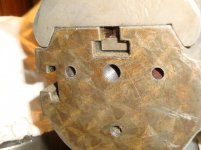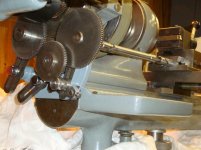L Vanice
Diamond
- Joined
- Feb 8, 2006
- Location
- Fort Wayne, IN
I have finished replacing missing parts on two Hardinge Cataract screw cutting attachments. And I just finished converting a Hardinge 1946 model 9" slide rest to work for screw cutting. Today I took the first cuts with it.
The pre-1946 Hardinge 7" and 9" slide rests all have extensions on the longitudinal feed screw, meant for use with the screw cutting attachments. But Hardinge designed a new slide rest in 1946 to go with the new dovetail bed lathes now known as the DV-59. Hardinge also made these slide rests with a base to fit any of the older 9" split bed lathes. The 1946 slide rest did not have provision for use with the screw cutting attachment. So I had to convert one to work, which was pretty simple in concept.
I bored a hole in the end of a longitudinal feed screw and soldered in a long plug. Then I turned the plug to the same dimensions as the end of the pre-1946 feed screws. I fitted a cast iron guide bushing to the hole in the left end of the slide. The only real trick was correcting the alignment of the feed nut so that the feed screw did not bind in the nut when constrained by the new bushing.
Here are some pictures, as many as I can add to one post.
Larry
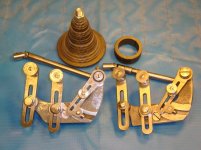

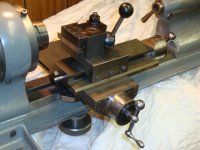
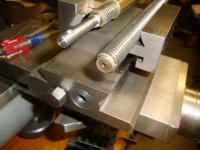

The pre-1946 Hardinge 7" and 9" slide rests all have extensions on the longitudinal feed screw, meant for use with the screw cutting attachments. But Hardinge designed a new slide rest in 1946 to go with the new dovetail bed lathes now known as the DV-59. Hardinge also made these slide rests with a base to fit any of the older 9" split bed lathes. The 1946 slide rest did not have provision for use with the screw cutting attachment. So I had to convert one to work, which was pretty simple in concept.
I bored a hole in the end of a longitudinal feed screw and soldered in a long plug. Then I turned the plug to the same dimensions as the end of the pre-1946 feed screws. I fitted a cast iron guide bushing to the hole in the left end of the slide. The only real trick was correcting the alignment of the feed nut so that the feed screw did not bind in the nut when constrained by the new bushing.
Here are some pictures, as many as I can add to one post.
Larry







